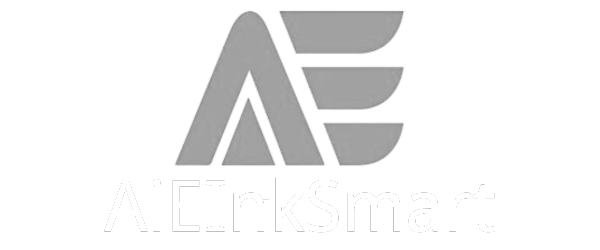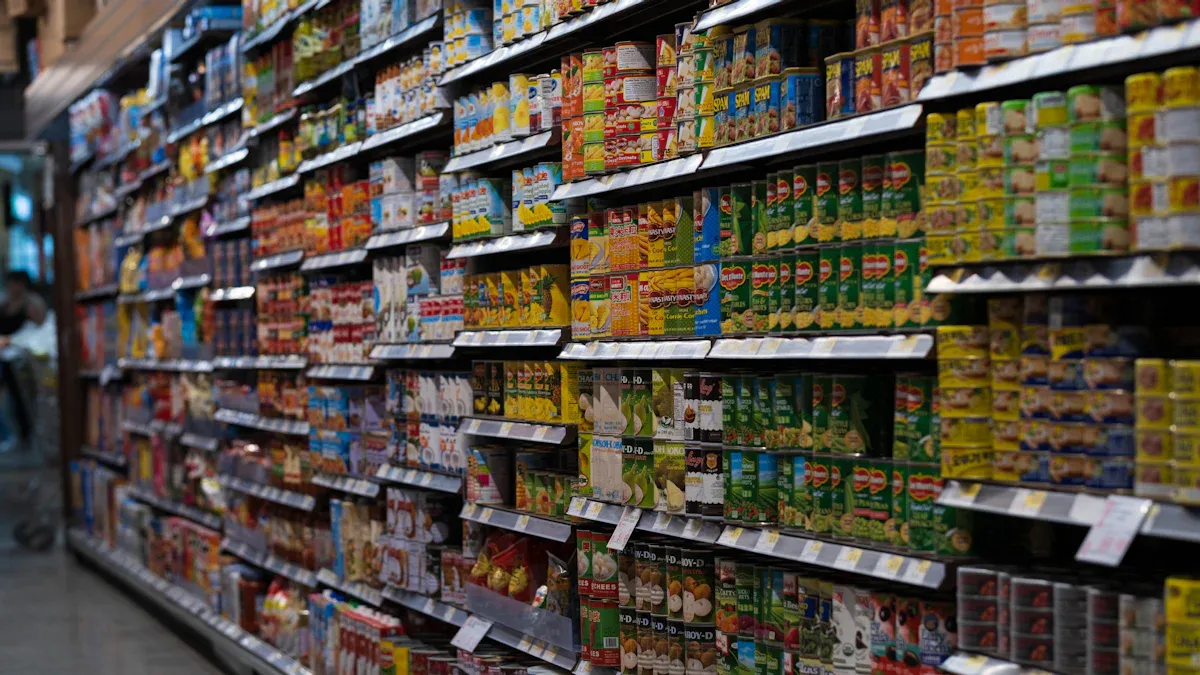
You will find that electronic shelf labels in modern Esl Retail environments rely on long-life lithium coin cell batteries, such as CR2032 or CR2450, to power each ESL Price Tag. In Europe, nearly 80% of supermarkets use this technology because these batteries deliver stable voltage and can last from 3 to 10 years, depending on usage and environment. With the support of energy-efficient e-paper displays and the ESL Gateway AP, you benefit from minimal maintenance while ensuring reliable, up-to-date pricing across your store.
- Typical battery lifespan ranges:
- 3–6 years with standard updates
- Up to 10 years with advanced management
Power Sources for Electronic Shelf Labels
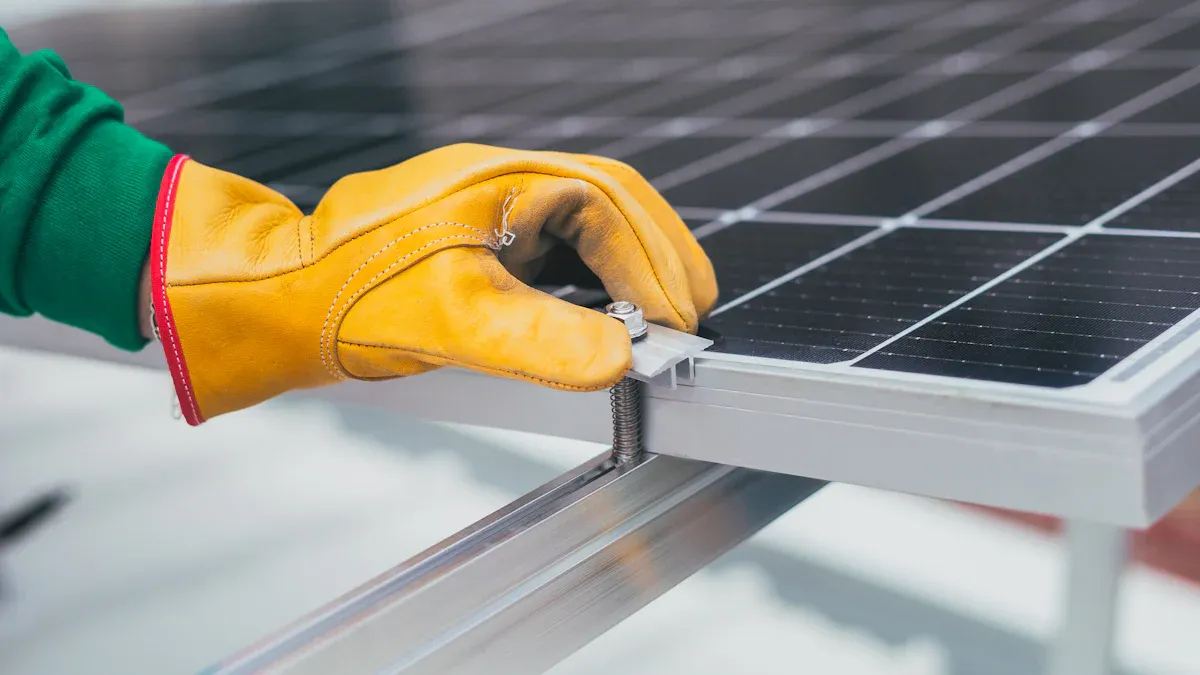
Modern electronic shelf labels rely on several power solutions to ensure reliable operation and minimal maintenance. You will find that most systems use batteries, but alternative options are emerging as technology advances.
Battery Types Used
Lithium Coin Cell Batteries
You will encounter lithium coin cell batteries as the most common power source for electronic shelf labels. These batteries, such as CR2032 or CR2450, deliver stable voltage and support long-term use. You benefit from their compact size and high energy density, which allow for slim label designs and multi-year operation. Most stores choose these batteries because they require little maintenance and provide consistent performance in various retail environments.
Rechargeable Battery Options
Some electronic shelf labels use rechargeable batteries. You can recharge these batteries during scheduled maintenance or through built-in charging systems. This approach reduces waste and supports sustainability goals. However, you must plan for periodic recharging, which can increase operational complexity compared to single-use coin cells.
Alternative Power Options
Wired Power (Rare Cases)
Wired power solutions, such as Power over Ethernet (PoE) or powerline communication (PLC), offer stable and reliable energy for electronic shelf labels. You can connect hundreds of devices on a single network, supporting large-scale deployments. For example, PLC-based systems operate on 12V-24V and maintain stable performance over distances up to 1 km. Wired power ensures consistent operation in busy retail environments, but you may face higher installation costs and less flexibility in label placement.
Energy Harvesting Methods (Solar, RF)
You may consider energy harvesting as a way to power electronic shelf labels without batteries or wires. This approach uses ambient energy sources, such as light or radio frequency (RF) signals, to generate electricity. Energy harvesting supports eco-friendly operations and reduces maintenance. However, current limitations in power efficiency and operational range restrict widespread adoption. You must carefully design your system to manage fluctuating energy availability and ensure reliable performance.
| Energy Harvesting Method | Advantages | Disadvantages |
|---|---|---|
| Solar Energy Harvesting | – Long expected lifetime (≥10 years), suitable for large-scale ESL deployments – Low maintenance cost – Proven reliable operation in small-scale setups over extended periods – Higher power density compared to RF | – Network operation challenges due to simultaneous wake-up/update requests after no-light periods (e.g., night), causing high network load – Dependent on availability of light, which can fluctuate |
| RF Energy Harvesting | – Can operate at a distance from the energy source – Suitable for remote or hard-to-reach locations – Eliminates wires, enabling flexible deployment | – Relatively small harvested energy, limiting use to low-power devices – Limited transfer distance and efficiency – Potential interference with other electronic devices |
Note: Both solar and RF energy harvesting require advanced power management and energy storage to handle fluctuating supply and maintain reliable operation.
Indoor Solar Cells
Indoor solar cells capture ambient light from store lighting to power electronic shelf labels. You can expect a long operational lifetime and low maintenance costs. This method works best in well-lit areas, but performance may drop in low-light conditions or during nighttime hours. You must consider network management to avoid high loads when many labels wake up after periods without light.
Active RF Energy Harvesting
Active RF energy harvesting converts radio frequency signals into usable electricity. You can deploy labels in hard-to-reach locations without running wires. This method offers flexibility and maintenance-free operation for very low-power devices. However, current technology limits conversion efficiency and transfer distance. You may see adoption increase as companies improve circuitry and multi-band capabilities, making RF harvesting more effective for electronic shelf labels in the future.
Display Technologies and Energy Consumption in Electronic Shelf Labels
Modern display technology shapes how you experience electronic shelf labels in retail environments. The choice of display impacts not only visibility and readability but also determines how long your ESLs can operate before needing maintenance or battery replacement. You will encounter several display types, each with unique energy profiles and operational benefits.
E-Paper Displays
How E-Paper Works
E-paper, also known as electronic ink or E-Ink, uses microcapsules filled with charged particles. When you update the display, an electric field moves these particles to create text or images. Once the image appears, the display holds it without drawing more power. This technology mimics the appearance of paper, providing high contrast and readability from multiple angles.
Why E-Paper Is Energy Efficient
You benefit from e-paper’s ultra-low power consumption. The display only uses energy during updates, not while showing static information. Industry research shows that e-paper can reduce power requirements by up to 99% compared to LCD or OLED. This efficiency allows battery-powered electronic shelf labels to last for years, even with frequent price changes. E-paper also performs well under bright store lighting or direct sunlight, making it ideal for retail environments focused on sustainability and cost savings.
Tip: E-paper displays help you achieve long-term savings by minimizing energy costs and reducing the frequency of battery replacements.
LCD Displays
Power Requirements of LCDs
LCD (liquid crystal display) technology relies on a backlight to illuminate the screen. You need to supply continuous power to keep the display visible, even when the content does not change. This constant energy draw shortens battery life and increases operational costs. Frequent updates further reduce battery longevity, especially in busy retail settings.
Comparison with E-Paper
You can compare LCD and e-paper displays using the following table:
| Feature/Aspect | LCD Electronic Shelf Labels (ESLs) | E-Ink Electronic Shelf Labels (ESLs) |
|---|---|---|
| Display Characteristics | Bright, dynamic, colorful; supports animations and flashing alerts | Paper-like, high contrast, readable from multiple angles |
| Power Consumption | Requires constant power to maintain brightness and animations | Consumes power only during display updates |
| Battery Life | Shorter due to continuous power use | Longer, lasting months to years |
| Energy Costs | Higher electricity bills due to constant power use | Minimal energy costs, leading to long-term savings |
| Environmental Impact | Larger carbon footprint due to higher energy consumption | Eco-friendly, aligns with sustainability goals |
| Use Case | Suitable for dynamic, attention-grabbing promotions | Ideal for static pricing and minimal maintenance environments |
You will notice that LCDs offer vibrant colors and dynamic features, but they require more frequent battery changes. E-paper, on the other hand, supports static pricing and reduces maintenance, making it the preferred choice for most electronic shelf labels.
Other Display Types
OLED Displays
OLED (organic light-emitting diode) displays provide rich colors and deep contrast. You can use OLEDs for attention-grabbing promotions or video content. However, OLEDs consume more power than e-paper and can suffer from screen burn-in over time. This higher energy demand makes OLED less suitable for battery-powered ESLs that require long operational life.
Segmented Displays
Segmented displays use predefined sections to show numbers or simple icons. You often find these in basic price tags or devices that do not need complex graphics. Segmented displays consume less power than LCDs but still require more energy than e-paper. They offer a balance between simplicity and efficiency, but they lack the flexibility and clarity of e-paper technology.
Note: Emerging technologies, such as hybrid displays and solar-powered ESLs, aim to combine the best features of each display type. You can expect future electronic shelf labels to become even more energy-efficient as these innovations mature.
Wireless Communication and Its Impact on Power for Electronic Shelf Labels
Wireless communication protocols play a crucial role in determining how long your electronic shelf labels can operate before needing maintenance. The choice of protocol directly affects battery life, update frequency, and overall system reliability.
Radio Frequency (RF) Communication
How RF Minimizes Power Use
RF communication protocols allow you to transmit data efficiently by using short bursts of energy. Many RF modules, such as the Silicon Labs EFR32FG22 Series 2, operate with ultra-low power consumption. For example, these modules draw only 8.2 mA during transmission at +6 dBm, 3.6 mA during reception, and just 1.2 µA in deep-sleep mode.
| Operating Mode | Power Consumption |
|---|---|
| Transmission (TX) at +6 dBm | 8.2 mA |
| Reception (RX) | 3.6 mA |
| Deep-sleep mode | 1.2 µA |
You benefit from these low figures because your labels can spend most of their time in sleep mode, waking only for scheduled updates. Some RF implementations extend battery life up to thirteen years, especially when you optimize update frequency and use batch updates during off-peak hours.
Typical Use Cases in Stores
You often see RF communication in large retail environments where you need to update thousands of labels simultaneously. RF protocols support reliable, long-range communication, making them ideal for supermarkets and big-box stores. You can reduce maintenance costs by choosing efficient RF solutions that balance update speed with battery longevity.
Bluetooth Low Energy (BLE)
BLE Power Efficiency
Bluetooth Low Energy (BLE) stands out for its ability to transmit data in short bursts, followed by long sleep periods. This approach allows your electronic shelf labels to operate for months or even years on a single coin cell battery. BLE modules, such as the EFR32BG22, typically use about 4.1 mA during transmission and 3.6 mA during reception, with deep sleep drawing only 1.2 µA. BLE’s low duty cycle and efficient radio design make it highly suitable for frequent updates without sacrificing battery life.
| Technology | Power Source | Power Consumption Characteristics | Suitability for Electronic Shelf Labels |
|---|---|---|---|
| BLE (Bluetooth Low Energy) | Battery-powered | Short data bursts, extended sleep states; long battery life | Supports frequent updates, real-time communication, and longer range |
Integration with Store Systems
You can integrate BLE with existing store systems to enable real-time price updates and inventory management. BLE supports mesh networking, which helps you synchronize thousands of labels across large areas. This technology ensures your pricing remains accurate while keeping maintenance needs low.
WiFi and NFC
Power Draw of WiFi
WiFi modules provide high-speed data transfer and cloud integration, but they consume more power than other wireless options. Frequent updates and constant connectivity can reduce battery life, leading to more frequent replacements and higher maintenance costs. You must carefully balance update frequency and efficiency when using WiFi for electronic shelf labels.
| Communication Module | Power Consumption Characteristics | Usage Pattern | Battery Life Impact |
|---|---|---|---|
| Wi-Fi | Higher power consumption; supports high-speed data transfer | Frequent updates, cloud integration | Reduces battery life; requires balancing update frequency and efficiency |
NFC for Short-Range Updates
NFC (Near Field Communication) uses very little power because it operates over short distances and for brief periods. You can use NFC for quick, close-range updates or customer interactions. This method has minimal impact on battery life, making it ideal for infrequent updates or special promotions.
| Communication Module | Power Consumption Characteristics | Usage Pattern | Battery Life Impact |
|---|---|---|---|
| NFC | Low power consumption due to limited range and brief use | Quick, close-range updates | Minimal impact on battery life due to sparse usage |
Tip: Choosing low-power protocols like BLE or NFC helps you reduce maintenance costs and ensures your electronic shelf labels remain reliable for years.
Battery Life and Longevity of Electronic Shelf Labels
Typical Battery Lifespan
You can expect modern electronic shelf labels to deliver impressive battery longevity. Most models use advanced lithium coin cell batteries, which allow smaller and mid-sized labels to operate for up to 10 years under typical usage. Larger displays generally support up to 5 years of battery life. Manufacturers like AVB Marketing and SOLUM have pushed these limits further by integrating energy-efficient communication protocols and enhanced battery technology. These improvements not only extend operational life but also reduce maintenance costs and environmental impact. Many labels now feature waterproof ratings such as IPX5 and IPX7, ensuring reliable performance in diverse retail environments.
Factors Affecting Battery Life
Several factors influence how long your electronic shelf labels will last before needing a battery replacement:
- Update Frequency: Each price update consumes power. Labels that update more often will see shorter battery life.
- Display Type: E-paper displays use less energy than LCDs or OLEDs, helping you maximize battery longevity.
- Operating Temperature: Extreme temperatures can reduce battery efficiency. Maintaining ESLs within recommended ranges (0°C to 40°C) helps preserve battery health.
- Wireless Protocols: Energy-efficient options like Bluetooth Low Energy (BLE) and RF communication minimize power draw during data transmission.
- LED Usage: Frequent use of LEDs for alerts or notifications increases energy consumption.
Note: Smart ESL systems can monitor battery health and optimize energy use automatically, further extending operational life.
Real-World Examples
You can look to real-world deployments for proof of ESL battery longevity. In one convenience store, 550 electronic shelf labels operated for over 5 years without battery replacement. UK retailers such as CJ Lang and Currys report battery warranties of seven years, with some labels lasting closer to 12 years in practice. Manufacturer data confirms that models like SOLUM’s Newton ESLs can achieve up to 10 years of battery life, reducing both replacement frequency and environmental impact.
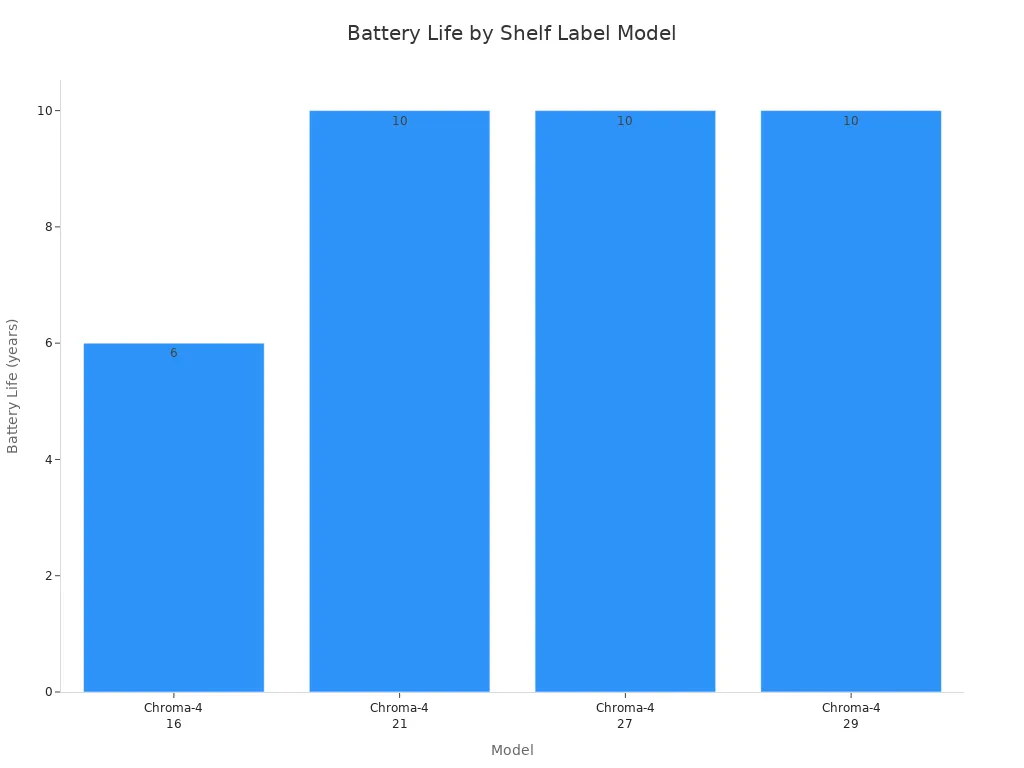
Power-Saving Features
You benefit from a range of power-saving features designed to maximize the lifespan of your electronic shelf labels.
Sleep Modes
Most ESLs spend the majority of their time in low-power sleep modes. The display only draws energy during updates, and the wireless module remains inactive until scheduled communication. This approach allows you to achieve multi-year battery life, even in busy retail settings.
Update Frequency Optimization
You can further extend battery life by optimizing how often your labels update. Scheduling updates during off-peak hours, limiting unnecessary button presses, and reducing LED usage all contribute to lower energy consumption. Some advanced models even power off when the store is closed, conserving battery for when you need it most.
| Model | Battery Life (years) | Updates per Day | Battery Type | LED Usage |
|---|---|---|---|---|
| Chroma-4 16 | 6 | Up to 3 | Replaceable long-life | Green flashing LED |
| Chroma-4 21 | 10 | Up to 3 | Replaceable long-life | Green flashing LED |
| Chroma-4 27 | 10 | Up to 3 | Replaceable long-life | Green flashing LED |
| Chroma-4 29 | 10 | Up to 3 | Replaceable long-life | Green flashing LED |
Tip: By choosing energy-efficient display types and optimizing update schedules, you can significantly reduce maintenance and ensure your ESLs remain reliable for years.
Installation and Maintenance of Electronic Shelf Labels
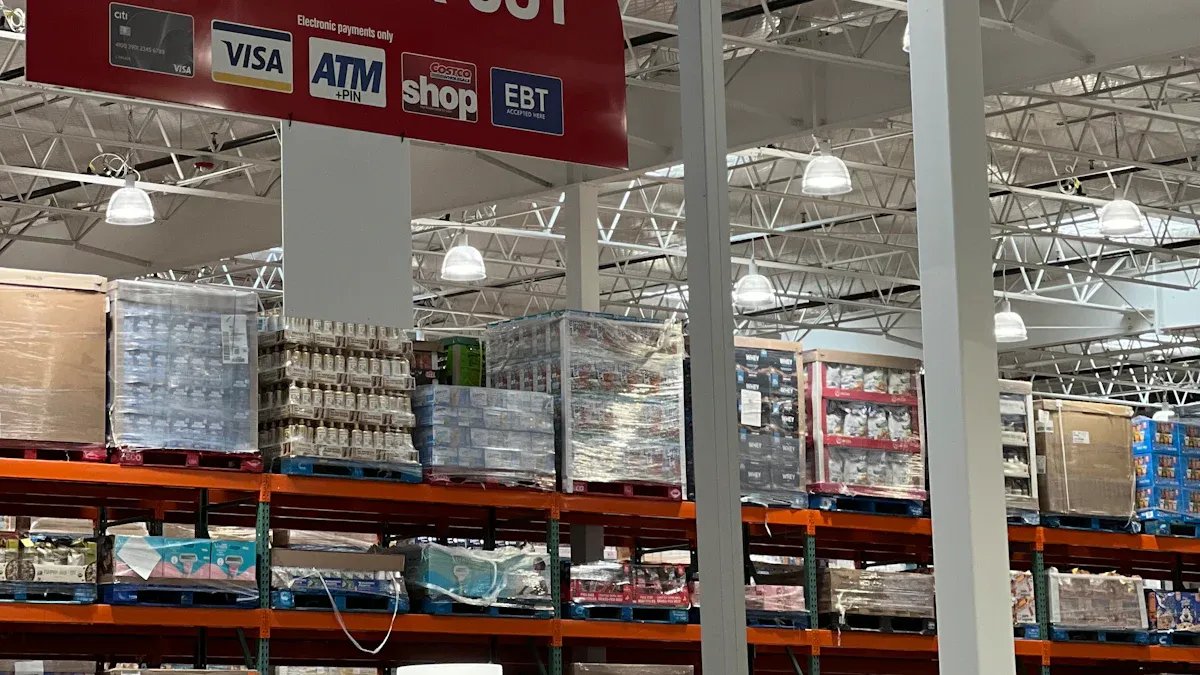
Initial Setup and Power Management
Battery Installation Process
You begin the installation of electronic shelf labels by preparing each unit for power. Most models use coin cell batteries, such as CR2450 or CR2430, which you can insert without specialized tools. Manufacturers design the battery compartment for quick access, allowing you to snap the battery into place securely. During large-scale deployments, you may organize the process by section or aisle to ensure consistency and efficiency. Proper battery installation at the start helps you avoid early failures and supports long-term reliability.
Tip: Train your staff on the correct battery installation technique to reduce errors and ensure every label starts with optimal power.
Power Testing During Setup
After installing the batteries, you should test each label to confirm proper operation. Many systems include a built-in power check or LED indicator that lights up when the battery connects correctly. You can use handheld scanners or mobile apps to verify that each label communicates with the store’s network. This step ensures that every label receives updates and displays accurate information from the beginning. A thorough initial setup reduces the risk of maintenance issues later.
You will notice that the initial setup process requires a higher investment and more technical steps than traditional paper labels. However, this complexity enables wireless updates and energy-efficient operation, which lowers your maintenance workload over time. Over a five-year period, you benefit from reduced labor, energy savings, and fewer material costs.
Ongoing Maintenance
Battery Replacement Procedures
You can maintain electronic shelf labels with minimal disruption by following best practices for battery replacement. Schedule regular inspections to identify labels with low battery indicators or reduced performance. Most modern ESLs allow you to replace batteries quickly, often without removing the label from the shelf. Staff training ensures that anyone can perform this task safely and efficiently. Use only recommended battery types to guarantee compatibility and maximize lifespan.
- Replace batteries during off-peak hours to minimize impact on store operations.
- Keep spare batteries in a controlled environment to preserve their quality.
- Dispose of used batteries responsibly to support sustainability initiatives.
Monitoring Battery Health
You should monitor battery health using real-time dashboards or monitoring tools provided by your ESL system. These platforms alert you when a label’s battery drops below a set threshold, allowing you to act before failures occur. Integrate your monitoring system with inventory and POS platforms to automate updates and reduce unnecessary battery usage. Maintain store conditions within recommended temperature and humidity ranges to prevent battery degradation. Avoid placing labels near heat sources or in poorly ventilated areas.
Note: Preventive maintenance, including regular cleaning and inspection, extends the life of both the label and its battery. Choose models with advanced battery technology for even longer performance.
Reliability and Operational Considerations for Electronic Shelf Labels
When you deploy electronic shelf labels in your store, you expect consistent performance and minimal disruptions. Achieving this reliability requires careful attention to both power supply and environmental conditions.
Ensuring Consistent Power Supply
Redundancy Measures
You can improve system reliability by implementing redundancy measures. Many retailers choose to keep spare batteries and backup labels on hand. Some advanced systems allow you to swap batteries without removing the label from the shelf, reducing downtime. You may also use dual-battery designs in critical areas, ensuring that a label continues to function even if one battery fails. These strategies help you maintain uninterrupted pricing and product information for your customers.
Alerts for Low Battery
Modern electronic shelf labels often include built-in alerts for low battery levels. You receive notifications through your management dashboard or mobile app when a label’s battery drops below a set threshold. This early warning system allows you to schedule replacements before any display failures occur. By acting promptly, you avoid pricing errors and maintain a seamless shopping experience.
Environmental Factors
Temperature Effects on Batteries
Environmental conditions play a significant role in the performance and reliability of your electronic shelf labels. Temperature and humidity can impact battery life and safety at every stage, from manufacturing to daily operation. The table below summarizes these effects:
| Stage | Effect of Temperature and Humidity on Battery Performance and Reliability |
|---|---|
| Raw Material Prep | High humidity causes oxidation, degrading material quality; temperature and moisture affect electrolyte stability and conductivity. |
| Cell Assembly | Excess moisture can cause short-circuiting; high temperature leads to chemical degradation, reducing battery performance. |
| Formation & Testing | Fluctuations in temperature/humidity can cause overheating, degradation, and failure to meet capacity or lifespan expectations. |
| Storage & Aging | Unstable temperature/humidity during storage leads to reduced capacity, faster self-discharge, and overall degradation, impacting reliability. |
| Overall Impact | Environmental control ensures quality, safety, longevity, and compliance. |
You should monitor store temperature and humidity to prevent battery degradation and ensure long-term reliability. Maintaining stable conditions reduces the risk of thermal runaway or short-circuiting, which protects both your investment and your customers.
Tip: Real-time monitoring of environmental data enables you to make timely adjustments, improving cost efficiency and reducing waste.
Store Layout and Signal Strength
Store layout can influence the reliability of wireless communication between your electronic shelf labels and the central system. Obstacles such as metal shelves, refrigeration units, or thick walls may weaken signal strength. You can address these challenges by strategically placing gateways or repeaters to ensure strong, consistent coverage throughout your store. Regular signal testing helps you identify and resolve weak spots before they affect label performance.
Industry reports highlight that advancements in battery and display technologies, such as e-ink and lithium manganese dioxide cells, have made electronic shelf labels more reliable and energy-efficient. These improvements support longer battery life, clearer visibility, and faster updates, even in challenging retail environments.
Benefits of Modern Power Solutions in Electronic Shelf Labels
For Retailers
Reduced Maintenance Costs
You will notice a significant drop in maintenance costs when you use modern power solutions for your store’s electronic shelf labels. These labels use energy-efficient e-ink displays and advanced batteries, which last for years with minimal intervention. Many models can even report their own condition, giving you advance notice before a replacement is needed. This proactive approach helps you avoid unexpected labor costs and keeps your operations running smoothly.
Light-powered labels, which capture energy from indoor lighting, further reduce the need for battery replacements. You no longer need to schedule frequent maintenance checks or worry about sudden power failures. By eliminating the recurring expenses of paper, ink, and printer upkeep, you save both time and money. Over time, these savings add up, especially when you consider the long lifespan of up to 10 years for many electronic shelf labels.
Tip: Automated alerts and real-time monitoring let you address issues before they disrupt your store, making your maintenance routine more efficient.
Improved Operational Efficiency
Modern power solutions transform how you manage your store. Automated price updates mean you do not have to spend hours changing paper tags. You can update thousands of prices instantly, reducing human error and freeing your staff to focus on customer service. Integration with inventory systems allows you to track stock levels and receive reorder alerts directly at the shelf.
You benefit from dynamic pricing, which lets you adjust prices in real time based on demand or competition. This flexibility helps you boost sales and respond quickly to market changes. Many retailers have reported up to an 80% reduction in labor costs and a 60% drop in manual errors after switching to electronic shelf labels. These improvements lead to faster restocking, better planogram compliance, and a more sustainable operation by cutting down on paper waste.
Key operational benefits include:
- Real-time price and inventory updates
- Automated promotions and dynamic pricing
- Enhanced staff productivity
- Reduced paper and ink usage
For Shoppers
Accurate Pricing
You provide your customers with accurate and consistent pricing by using electronic shelf labels. Automated updates nearly eliminate the human errors common with manual price tags. Studies show that traditional labels can have error rates as high as 24%, while electronic shelf labels reduce pricing mistakes by up to 50%. Prices at the shelf always match those at checkout, which builds trust and prevents disputes.
Real-time synchronization with your inventory and POS systems ensures that every price change is reflected instantly. Shoppers can rely on the information they see, making their experience smoother and more transparent.
Enhanced Shopping Experience
Modern electronic shelf labels do more than display prices. They offer shoppers easy access to detailed product information, such as nutrition facts, origin, and sustainability details. Interactive features like QR codes and NFC tags allow customers to scan for reviews, personalized offers, or even self-checkout options.
You help your customers make informed decisions by providing real-time stock updates and clear promotions. These features reduce frustration, speed up transactions, and create a seamless shopping journey. Consistent and transparent pricing, combined with rich product information, encourages loyalty and satisfaction.
Note: By adopting these advanced solutions, you not only improve your store’s efficiency but also create a more engaging and reliable environment for your shoppers.
You gain a reliable solution with electronic shelf labels that use advanced batteries and energy-efficient displays. Recent studies highlight how innovations like solar power, e-ink technology, and Bluetooth Low Energy reduce maintenance and support sustainability.
- Solar-powered and energy-harvesting ESLs lower your operational costs and environmental impact.
- E-paper displays and IoT integration help you achieve real-time updates and longer device life.
These advancements make electronic shelf labels a practical and future-ready choice for modern retail.
FAQ
How long do electronic shelf label batteries last?
You can expect most electronic shelf label batteries to last between 3 and 10 years. Battery life depends on update frequency, display type, and store conditions. E-paper displays and optimized update schedules help you maximize battery longevity.
Can you replace the batteries in electronic shelf labels?
You can replace batteries in most electronic shelf labels. Manufacturers design battery compartments for quick access. You should use the recommended battery type to ensure reliable performance and long operational life.
Do electronic shelf labels work in low-light areas?
You can use electronic shelf labels in low-light areas. Battery-powered models operate independently of lighting conditions. Solar-powered labels require consistent light, so you should place them in well-lit sections for best results.
How do you know when a label’s battery is low?
You receive alerts through your management dashboard or mobile app when a label’s battery drops below a set threshold. This early warning helps you schedule timely replacements and avoid display failures.
Are electronic shelf labels waterproof?
You can find electronic shelf labels with waterproof ratings such as IPX5 or IPX7. These models withstand spills, humidity, and cleaning. You should check the product specifications to match your store’s environment.
Can you update prices on all labels at once?
You can update prices on thousands of labels simultaneously using wireless communication protocols like RF or BLE. This feature saves you time and ensures pricing accuracy across your entire store.
What happens if wireless communication fails?
You may experience temporary delays in updates if wireless communication fails. Most labels retain their last displayed information until the connection restores. You should monitor network health and use repeaters or gateways to maintain strong coverage.


